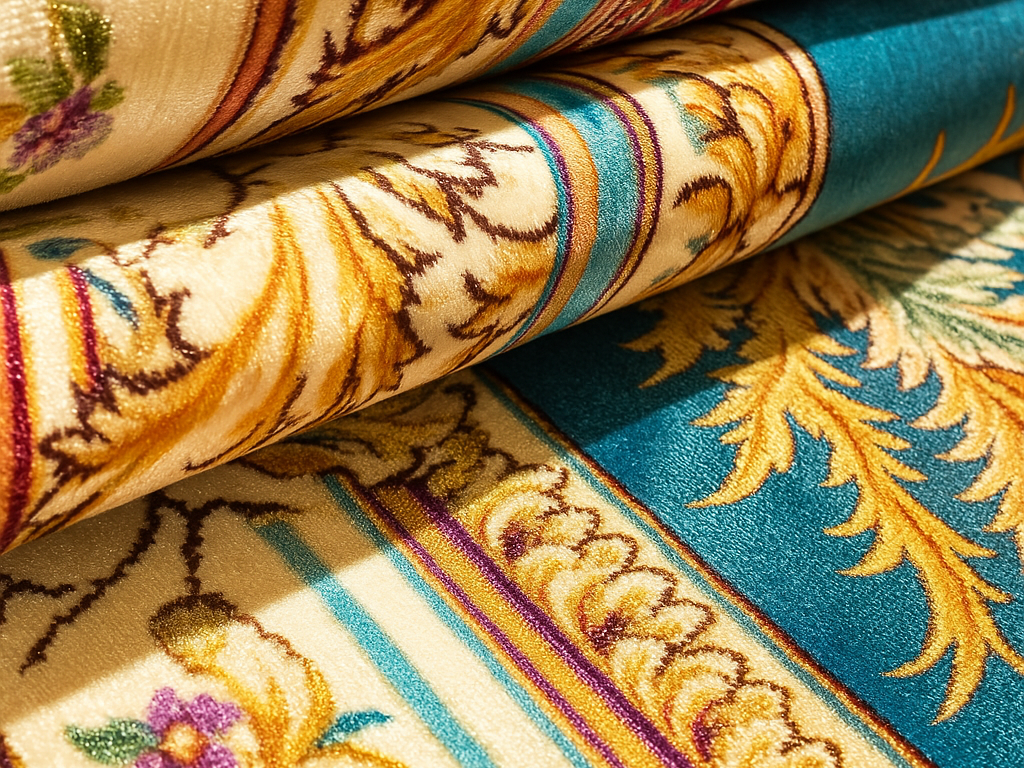현대의 오피스 디자인은 지속 가능성, 건강, 음향적 편안함, 스타일에 중점을 두면서 빠르게 진화하고 있습니다. 카펫은 더 이상 단순한 바닥재가 아니라 브랜드 정체성을 강화하고, 하이브리드 업무 모델을 지원하며, 직원의 성공을 돕는 전략적 디자인 도구입니다. 선택의 폭을 넓히고 2025년에 완벽한 오피스 카펫을 선택하는 방법을 알아보세요.
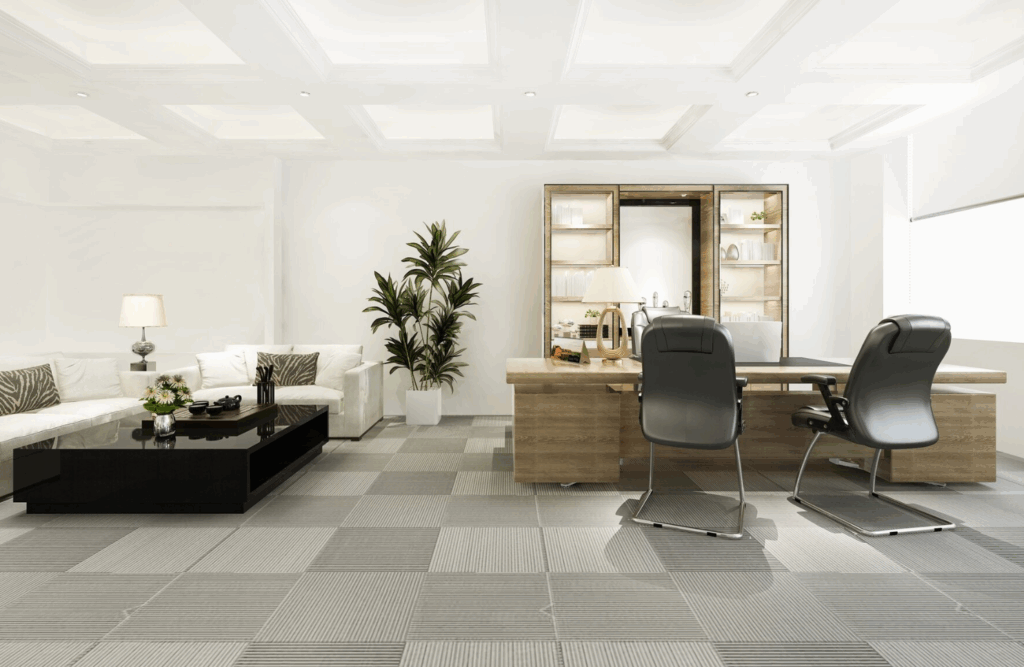
1. 사무실 카펫 이해하기
사무실 카펫은 미적 감각 그 이상입니다. 유동인구가 많고, 소음을 제어하며, 실내 공기질을 개선하도록 설계된 기능성 표면입니다.
- 정의 및 수명: 카펫은 일반적으로 벽에서 벽까지 설치하는 것을 말하며, 적절한 유지 관리를 통해 약 15~18년 동안 지속됩니다.
- 주요 이점: 카펫 쿠션 바닥 : 소음을 줄이고, 따뜻함을 더하고, 먼지와 알레르기 유발 물질을 걸러주며, 리셉션 공간이나 회의실과 같은 공간에서 전문성을 알릴 수 있습니다.
- 기업 내러티브의 잠재력: 카펫은 염료 기술과 모듈형 포맷을 통해 넓은 작업 공간에 브랜드 색상, 로고 또는 길 찾기 그래픽을 반영할 수 있습니다.
2. 사무실 카펫에 대한 고려 사항
적합한 오피스 카펫 선택하기 기능적 성능과 디자인, 비용의 균형을 맞추는 동시에 공간의 일상적인 현실을 예측해야 합니다. 오늘날의 카펫은 내구성과 미적 매력 외에도 브랜드, 편안함, 장기적 가치에 있어 전략적 자산으로 작용합니다. 균형 잡힌 선택을 하는 방법은 다음과 같습니다:
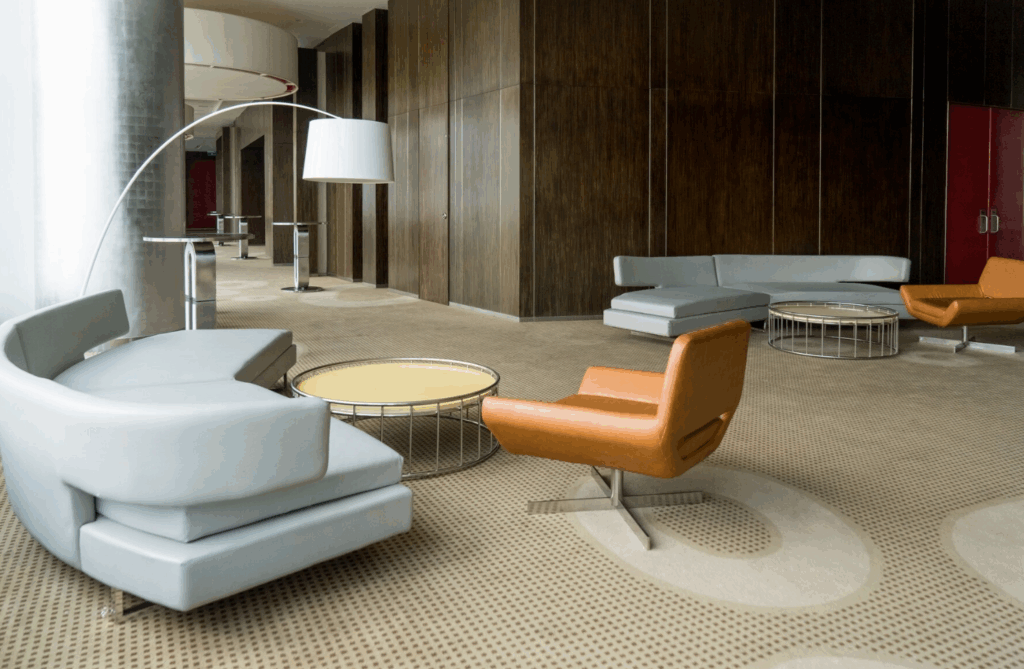
유동인구 및 지역 사용
구역마다 다른 카펫 사양이 필요합니다:
- 트래픽이 많은 지역 (복도, 입구 영역): 선택 루프 파일 또는 지속적인 발걸음을 견딜 수 있도록 튼튼한 뒷면이 있는 로우컷의 고밀도 섬유로 제작되었습니다. 이러한 카펫은 매트 현상을 방지하고 외관을 유지하며 흠집을 숨기는 데 도움이 됩니다.
- 보통 영역 (워크스테이션, 회의실): 컷-파일 또는 컷 앤 루프 구조는 적절한 탄력성으로 더욱 편안한 착용감을 제공합니다.
- 가벼운 사용 영역 (임원실, 리셉션): 미적 감각을 우선시하여 전문성을 전달하는 고급스러운 질감을 선택합니다.
내구성 및 백업 시스템
카펫의 수명은 섬유의 품질, 뒷면, 파일 밀도에 따라 달라집니다:
- 후원: 쿠션 지원 타일로 충격을 완충하고 수명을 향상시킵니다. 오픈 셀 쿠션 백킹 는 폐쇄형 셀 유형보다 훨씬 더 나은 성능을 발휘하여 압축 후 모양을 되찾습니다.
- Yarn 구성 및 밀도: 섬유 트위스트 열 설정 복원력을 유지합니다. 더 높음 파일 밀도 는 섬유가 더 단단하게 쌓일수록 구부러짐과 마찰이 줄어들어 섬유가 마모되지 않도록 도와줍니다.
- 파이버 유형: 헤비 듀티 나일론 는 단단하지만 재활용성이 떨어지는 반면 나일론 는 내구성은 약간 낮지만 친환경성이 더 뛰어납니다.
음향 및 열 성능
- 사운드 제어: 사무실 환경은 소음을 흡수하는 카펫의 이점을 누릴 수 있습니다. 카펫을 선택하면 소리 전달을 최대 20dB까지 줄일 수 있어 조용하고 집중할 수 있는 분위기를 조성할 수 있습니다.
- 절연: 카펫 섬유는 공기를 가두어 자연적인 열 저항을 제공하므로 실내 온도를 2~3°C까지 안정시키고 공조 비용을 절감할 수 있습니다.
유지보수 및 얼룩 관리
- 손쉬운 청소: 얼룩 방지 마감 처리된 섬유 선택 - 나일론, 올레핀, PTT는 양모보다 습기와 얼룩에 더 잘 견딥니다.
- 색상 및 패턴: 패턴이있는 중간 톤 색상은 밝은 색이나 단색보다 먼지와 표백제 유출을 더 잘 숨 깁니다.
- 유지 관리 전략: 사용 빈도가 높은 구역을 매일 진공 청소기로 청소하고, 직원에게 스팟 처리를 교육하고, 6~12개월마다 전문 심층 청소를 예약하는 등 강력한 청소 루틴을 구축하세요.
건강, 안전 및 실내 공기질
- 카펫은 실내 공기질에 알레르기 유발 물질과 메이크업을 가둡니다.적절한 유지보수 및 저-VOC 재료 는 재발을 방지하고 건강을 유지하는 데 필수적입니다.
- 전자 제품이나 인화성 물질이 있는 민감한 환경의 경우 다음 사항을 고려하세요. 정전기 방지 섬유 정전기 축적을 방지하고 장비를 보호합니다.
지속 가능성 및 재료 투명성
2025년에 지속 가능성은 타협할 수 없습니다:
- 다음과 같은 카펫을 선택하세요. 재활용 콘텐츠, 저-VOC 인증, 재활용 또는 재사용이 가능한 백킹을 사용합니다.
- 고려 사항 요람에서 요람으로 재활용 또는 바이오 기반 재료를 사용하는 인증된 공급업체.
예산 및 라이프사이클 계획
- 강력한 뒷면과 내구성이 뛰어난 섬유를 사용한 고품질 카펫에 대한 초기 투자로 다음과 같은 이점을 얻을 수 있습니다. 상당한 비용 절감 교체 및 유지보수 필요성을 줄여줍니다.
- 카펫 보증 확인 - 상업용 카펫에는 적절한 사용 및 유지 관리와 관련된 10~30년 보증이 적용되는 경우가 많습니다.
관련 읽기: 호텔 & 호스피탈리티 카펫 가이드 2025
3. 사무실 카펫의 종류
올바른 종류의 사무실 카펫을 선택하는 것은 단순히 외관뿐만 아니라 업무 공간의 요구사항에 맞는 성능, 내구성, 심미성, 편안함, 비용의 균형을 맞추는 것이 중요합니다. 주요 유형에 대해 자세히 알아보세요:
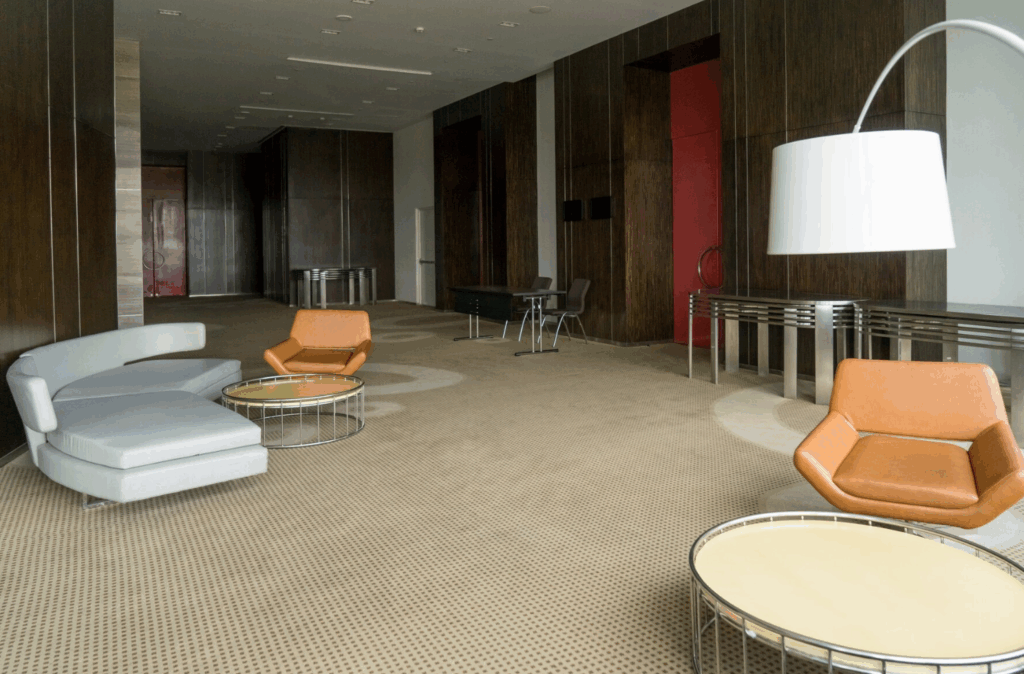
카펫 섬유
나일론
- 상업용 업계 표준으로 견고하고 탄력적이며 색상이 강합니다.
- 얼룩과 마모에 강하며 프리미엄 버전은 수명과 변색에 대한 저항력이 뛰어납니다.
- 트래픽이 많은 영역에서는 루프 또는 텍스처 스타일이 선호되는 경우가 많습니다.
폴리에스테르 / PET / PTT
- 친환경 인증을 받은 생생한 용액 염색 섬유(예: 재활용 병에서 추출한 PET)를 사용합니다.
- 소수성 특성으로 유출을 방지하지만 많이 사용하면 납작해질 수 있습니다.
- PTT(예: 소로나®)는 부분적인 바이오 기반 원료를 사용하여 나일론의 탄력성을 모방합니다.
올레핀(폴리프로필렌)
- 얼룩에 강하고 습기에 강해 습기가 많은 공간에 이상적입니다.
- 탄력성이 떨어지고 교통량이 많은 지역에서는 매트해지는 경향이 있습니다.
울 & 울 혼방
- 고급스러운 천연 섬유로 내구성이 뛰어나고 방염성이 있으며 염색이 용이합니다.
- 내구성을 높이기 위해 울과 합성섬유(예: 80/20 혼방)를 혼합한 저렴한 옵션이 있습니다.
아크릴
- 양모 질감을 모방하고 우수한 견뢰도를 제공합니다.
- 필링이 발생하기 쉬우며 수요가 많은 사무실에서는 덜 일반적으로 사용됩니다.
파일 구조 및 스타일
섬유가 배열되는 방식은 착용 패턴, 편안함, 외관에 영향을 미칩니다:
루프 파일(예: 레벨 루프, 베르베르)
- 모든 루프는 잘리지 않고 내구성이 뛰어나며 세척이 용이하여 많이 사용하기에 이상적입니다.
- 클래식한 루프 스타일인 버버는 먼지를 잘 숨기고 눈에 띄는 마모 없이 발자국을 잘 견뎌냅니다.
컷 더미(예: 플러시, 색소니, 프리즈)
- 원사 고리가 잘려서 부드러운 표면이 만들어집니다.
- 플러시 및 작센은 고급스러운 느낌을 주지만 교통량이 많은 곳에서는 발자국이나 매트가 보일 수 있습니다.
- 프리즈는 플러시 소재보다 내구성이 뛰어나고 마모를 더 잘 감춰주는 트위스트와 질감을 더합니다.
컷 앤 루프 / 조각
- 컷과 루프 섬유를 결합하여 패턴과 텍스처를 만듭니다.
- 시각적으로 풍부하고 얼룩을 잘 숨기지만 복잡한 디자인은 마모가 고르지 않게 보일 수 있습니다.
형식: 브로드룸 대 카펫 타일
브로드룸
- 쿠션 패드에 벽에서 벽까지 설치하면 매끄럽고 고급스러운 외관을 연출할 수 있습니다. .
- 평방 피트당 비용 효율적이며 합성 쿠션으로 편안함을 더합니다.
- 수리하기 어려운 경우: 얼룩이 생기면 전체 부분을 교체해야 할 수도 있습니다.
카펫 타일(모듈형)
- 뒷면이 통합된 정사각형 조각으로 설치, 교체 및 재구성이 간편합니다.
- 창의적인 레이아웃, 구역별 디자인, 효율적인 유지보수를 지원하여 동적인 환경에 적합합니다.
- 초기 비용이 높고, 봉인하지 않으면 이음새가 보일 수 있습니다.
관련 읽기: 터프티드 러그에 대한 궁극의 가이드: 장인 정신, 관리 및 고려 사항
4. 사무실 카펫의 장점
신중하게 사용한다면 카펫은 단순한 표면이 아니라 현대 오피스 디자인의 전략적 자산이 될 수 있습니다. 카펫이 어떻게 공간을 가장 중요한 방식으로 변화시키는지 살펴보세요:
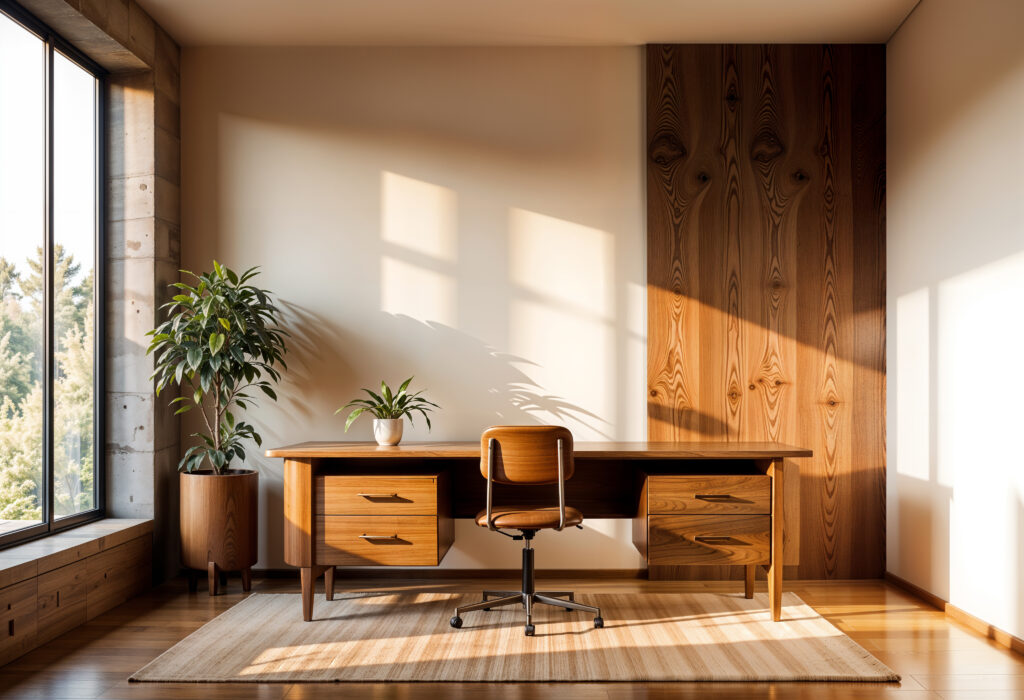
음향 및 집중력 향상
- 노이즈 감소: 카펫은 발자국 소리, 의자 움직임, 잔향을 흡수하여 단단한 바닥재에 비해 배경 소음을 2~4dB까지 줄여줍니다.
- 집중력 지원: 개방형 레이아웃에서 카펫은 전화 소리, 타이핑 소리, 발자국 소리 등 방해가 되는 소리를 줄여주어 집중력을 높이고 방해 요소를 줄여줍니다.
조용한 환경에 있는 직원들은 집중력이 향상되고 스트레스가 줄어든다고 보고하는 등 카펫이 생산성에 미치는 영향은 측정할 수 있습니다.
편안함 및 인체공학
- 발 피로 예방: 부드러운 표면은 특히 장시간 서 있거나 걸을 때 발과 관절에 가해지는 부담을 덜어줍니다.
- 열적 편안함: 카펫은 천연 단열재 역할을 하여 겨울철에 공간을 더 따뜻하게 유지하고 공조 장치 의존도를 줄여 몇 도를 절약하고 에너지 사용량을 줄입니다.
- 미끄럼 방지 안전: 카펫은 자연스러운 접지력을 제공하여 미끄러짐 위험을 줄여줍니다. 넘어질 경우 쿠션이 있는 바닥재는 더 심각한 부상을 방지합니다.
건강 및 실내 공기질
- 알레르겐 관리: 카펫 섬유는 대기 오염 물질을 순환시키는 대신 먼지와 알레르기 유발 물질을 가둡니다. 정기적으로 청소하면 공기질을 개선할 수 있습니다.
- 카펫을 포함한 건강한 실내 환경은 업무 만족도를 높이고 웰빙을 개선하는 것과 관련이 있습니다.
비용 효율성 및 수명주기 가치
- 내구성 보상: 고품질 상업용 카펫은 적절한 유지 관리를 통해 10~30년 동안 사용할 수 있으며, 다른 단단한 바닥재에 비해 총 비용이 저렴합니다.
- 저렴한 유지보수 비용: 일상적인 진공 청소기와 주기적인 딥 클리닝은 딱딱한 바닥을 다시 포장하는 것보다 더 쉽고 일반적으로 저렴합니다.
디자인 유연성 및 브랜딩
- 미적 다양성: 대담한 기하학적 타일부터 미묘한 질감, 맞춤형 브랜딩까지 카펫을 사용하면 공간에 회사의 정신을 반영하고 구역을 구분할 수 있습니다.
- 모듈식 창의성: 카펫 타일은 통로, 열린 회의 공간 또는 조용한 구역을 정의할 수 있으며, 디자인을 변경하려면 바닥 전체를 뜯어낼 것이 아니라 타일을 교체해야 합니다.
안전, 규정 준수 및 웰니스 목표
- 미끄러짐 및 충격 안전: 카펫의 강한 접지력은 사고를 예방하고 쿠션감이 있는 표면은 부상의 심각성을 줄여줍니다.
- 음향 표준: 많은 국내 및 국제 작업장 가이드라인에서는 특정 소음 기준치를 요구합니다. 적절하게 설계된 카펫 시스템은 이러한 음향 규정을 충족하는 데 도움이 됩니다.
- 직원 복지: 편안함을 개선하고 환경 스트레스 요인을 줄임으로써 고품질 바닥재는 웰빙 프로그램을 지원하고 WELL 또는 LEED와 같은 인증에 부합합니다.
생산성 및 심리적 웰빙
- 초점 향상: 제어된 음향과 부드러운 질감으로 감각의 피로를 줄여줍니다. 한 설문조사에서 44%의 직원이 생산성 저하의 원인으로 소음을 꼽았습니다. .
- 차분하면서도 활기찬 분위기: 부드러운 가을 질감과 따뜻한 톤이 어우러져 창의력과 협업에 이상적인 전문적이면서도 친근한 분위기를 조성합니다.
관련 읽기: 러그 종류에 대한 궁극의 가이드: 소재, 직조 및 인테리어 핏
5. 사무실 카펫에 적합한 색상 선택하기
색상 선택은 미적 감각을 넘어 직원 행동, 브랜드 이미지, 장기적인 실용성에 영향을 미치는 전략적 결정입니다. 사무실을 멋지고 스마트하게 꾸밀 수 있는 색상을 선택하는 방법을 알아보세요:
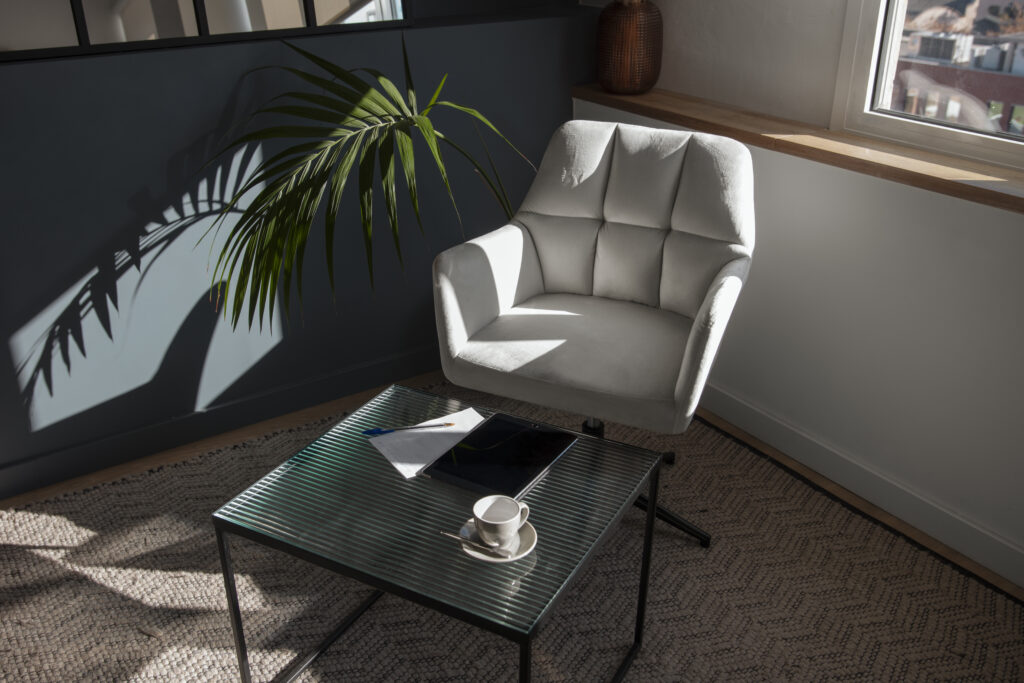
카펫 색상의 심리적 영향
- 생산성 및 집중력:
- 블루 톤 집중력과 신뢰성을 향상시켜 분석 구역이나 조용한 구역에 이상적입니다.
- 그린 카펫 평온함을 조성하고 스트레스를 줄이며 자연스럽고 웰빙에 초점을 맞춘 분위기를 불러일으킵니다. .
- 창의력 및 에너지:
- 따뜻한 액센트 (빨강, 주황, 노랑) 색상은 창의력과 활력을 자극하여 브레인스토밍 허브에 적합합니다.
- 흙빛 갈색 팬톤의 2025년 올해의 컬러 “모카 무스'처럼 따뜻함과 안정감, 자연스러운 유대감을 전달합니다.
- 중립 및 균형:
- 중성 회색, 베이지, 회갈색 는 시각적으로 차분한 환경을 조성하고 자연광을 증폭시키며 다양한 가구와 잘 어울립니다.
잘 고려된 컬러 요가는 직원의 기분과 성과를 향상시키지만, 톤이 맞지 않으면 집중력과 브랜드 명확성을 저해할 수 있습니다.
2025년 트렌드 컬러
사무실 카펫이 나아갈 방향을 예측하는 인테리어 디자인의 매력적인 트렌드:
- 미묘한 격자무늬와 텍스처: 부드러운 격자무늬 카펫이 고급 사무실에 이상적인 깊이와 촉감을 더하며 다시 돌아오고 있습니다.
- 흙빛 팔레트: 따뜻한 베이지, 브라운, 차분한 녹색은 편안함을 선사하고 직원들을 자연과 연결하여 웰빙을 향상시킵니다.
- 버터 옐로우 액센트: 주방부터 카펫까지 부드러운 버터빛 노란색이 과하지 않으면서도 낙관적이고 아늑한 분위기를 연출합니다.
- 모카 및 진한 브라운 톤: 2025년 올해의 컬러에 뿌리를 둔 딥 브라운은 세련되고 시대를 초월한 분위기를 자아내며 주목받는 공간에 잘 어울립니다. .
이러한 트렌드는 기업 환경에서는 충분히 미묘하지만 구역별 영역이나 강조 섹션에 적용하면 강력한 효과를 발휘합니다.
기능 및 공간에 맞는 색상 매칭
다양한 사무실 시나리오에 전략적인 컬러 매핑을 사용하세요:
- 교통량이 많은 복도: 중간 톤의 무채색이나 무늬가 있는 카펫(예: 격자무늬)을 선택하면 마모를 숨기고 유지 관리를 간소화할 수 있습니다.
- 조용한 워크스테이션: 시원한 파란색이나 녹색은 집중력과 차분함을 길러줍니다.
- 협업 영역: 따뜻한 액센트 색조나 흙색 톤을 사용하여 부담스럽지 않으면서도 창의적인 에너지를 자극할 수 있습니다.
- 리셉션/로비 공간: 진한 모카나 따뜻한 뉴트럴 컬러는 차분하고 프로페셔널한 첫인상을 줍니다.
- 브랜드 액센트: 스트라이프나 삽입된 디자인을 통해 회사 색상의 힌트를 사용하여 전체적인 차분함을 유지하면서 정체성을 강화하세요.
카펫 색상 선택을 위한 실용적인 팁
- 자연 채광의 중요성: 카펫은 일광과 LED 아래에서 다르게 보입니다. 실제 공간에 샘플 견본을 가져와 하루 중 다양한 시간대에 검토하세요.
- 트렌드와 수명의 균형: 액센트 영역은 버터 옐로우나 차분한 핑크와 같은 트렌디한 컬러를, 베이스 레이어는 견고한 뉴트럴 컬러를 사용하세요.
- 텍스처가 패턴보다 우선: 리브 루프, 컷 루프 조각 패턴과 같은 텍스처 변형으로 먼지를 숨기면서 시각적 깊이를 더할 수 있습니다.
- 모듈식 및 스왑 레디: 카펫 타일을 사용하면 작은 영역에서 대담한 색상을 테스트하고 전체 바닥을 다시 작업하지 않고도 업데이트할 수 있습니다.
6. 발학 전문가로부터 사무실 카펫에 대한 더 많은 팁 얻기
에서 ValHak, 의 팀은 지능형 러그 솔루션을 통해 사무실 공간을 혁신하는 데 특화되어 있습니다:
- 맞춤형 브랜딩 카펫: 로고나 시각적 언어를 바닥재에 직조하는 고속 염료 인쇄를 자체적으로 제공합니다.
- 모듈형 솔루션: 민첩한 업무 환경을 위해 손쉽게 교체하거나 재배치할 수 있는 지속 가능한 카펫 타일 시스템을 제공합니다.
- 전문가의 음향 조언: 소음 제어 목표에 맞는 파일 높이, 패딩 및 배치를 권장합니다.
- 지속 가능성 인사이트: 업계 표준에 따라 인증되고 웰빙 피드백이 포함된 저-VOC, 탄소 중립 옵션으로 고객을 안내합니다.
- 테스트 설치: 임시 레이아웃을 통해 작업 공간의 교통 패턴과 색상 인식을 시뮬레이션하여 자신 있게 결정할 수 있습니다.
7. 사무실 카펫 보호 및 관리 방법
사무실 카펫의 외관과 성능을 유지하려면 사전 예방적 관리, 정기적인 유지보수, 스마트한 보호 전략이 필요합니다. 2025년, 유지 관리는 단순히 청결을 유지하는 것뿐만 아니라 직원의 웰빙, 환경 규정 준수, 바닥재 투자 연장을 위한 것입니다. 사무실 카펫을 안전하게 관리하기 위한 고급 가이드를 소개합니다:
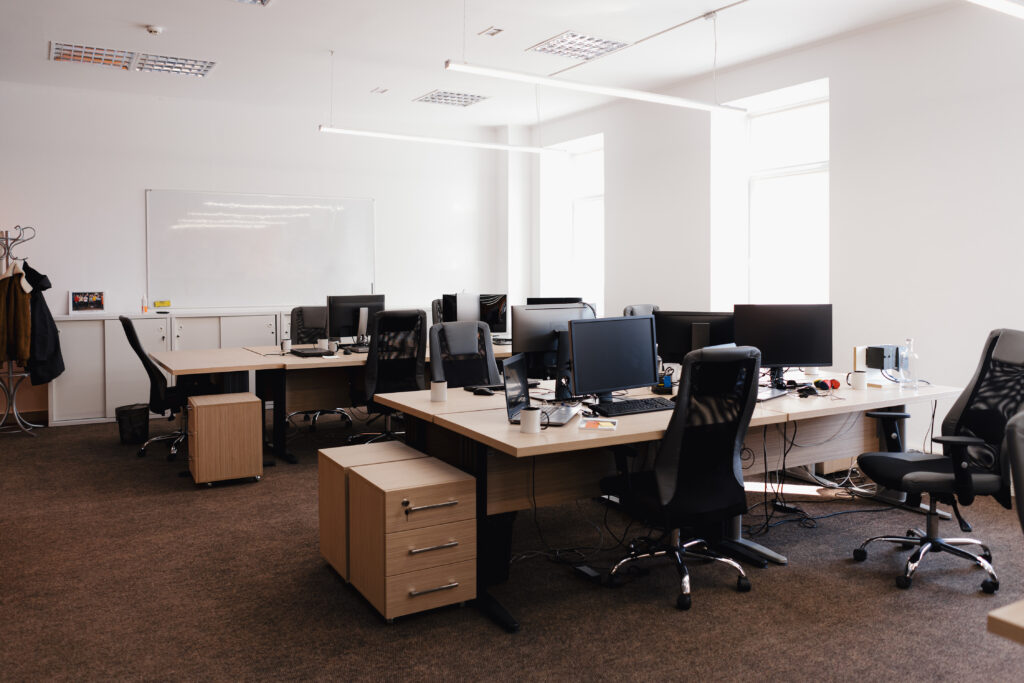
예방 조치: 오염이 시작되기 전에 차단하기
- 입구 매트 시스템 모든 입구에 레이어드 매트(스크레이퍼+흡수제)를 설치하면 최대 다음까지 걸러낼 수 있습니다. 85%의 그릿과 습기, 를 사용하여 실내 카펫의 마모를 획기적으로 줄입니다.
- 신발 정책 및 가구 교체 민감한 작업 공간에서는 “야외 신발 금지” 규칙을 고려하세요. 몇 달마다 책상 의자나 공간 배치를 교체하면 영구적인 압박과 섬유 붕괴를 방지할 수 있습니다.
- UV 윈도우 처리 햇빛에 의해 카펫 염료가 변색되는 경우 자외선 차단 필름이나 블라인드를 설치하여 시간이 지나도 색상이 변하지 않도록 보호하세요.
매일 및 중간 청소: 토양 관리
- 매일 진공 청소기로 청소하세요: 복도나 협업 공간과 같이 통행량이 많은 구역에 집중하여 HEPA 필터와 듀얼 모터가 장착된 CRI 인증 진공청소기를 사용하세요.
- 스팟 청소: 얼룩이 더 깊어지지 않도록 문지르지 말고 즉시 얼룩을 닦아내고 제조업체에서 승인한 얼룩 처리 방법을 따르세요.
- 저습도 중간 청소: 드라이 캡슐화 또는 보닛 청소와 같은 방법은 카펫을 빠르게 건조하고 방해가 덜한 딥 클리닝 사이에 새것처럼 유지합니다.
심층 및 복원 청소: 성능 초기화
일상적인 사전 조치에도 불구하고 매립된 토양은 주기적이고 집중적인 청소가 필요합니다:
- 온수 추출(스팀 청소) 이 복원 청소는 뜨거운 물과 안전한 세제를 사용하여 깊은 먼지와 알레르기 유발 물질을 씻어내는 CRI 및 인터페이스 권장 방식입니다.
- 건식 컴파운드 및 캡슐화 초저습 시스템은 흙을 가두는 건조한 잔여물을 남기지 않고 진공으로 빠르게 건조하므로 24시간 연중무휴 사무실에서 사용하기에 이상적입니다.
- 거친 토양을 위한 화학적 추출 특수 용매는 추출 전에 기름을 분해하므로 카페테리아 구역이나 실험실에 적합합니다.
- 전문 아웃소싱 경험이 풍부하고 친환경적인 청소 팀과 협력하여 보증 준수, 품질 관리, 최적의 제품 선택을 보장합니다.
카펫을 장기적으로 보호
- 패턴 및 백업을 다시 살펴보세요: 카펫 타일은 마모된 타일 교체를 간소화하고, 넓은 공간은 매핑된 유지 관리와 전략적 리프레시 구역의 이점을 누릴 수 있습니다.
- 패딩을 정기적으로 교체하세요: 쿠션 뒷면은 시간이 지남에 따라 마모되며 5~7년마다 교체하면 탄력성과 편안함을 유지합니다.
- 보증 준수 여부를 모니터링합니다: 권장 청소 일정과 재료를 준수하여 커버리지를 유지하세요. 구체적인 요구 사항은 제조업체에 문의하세요.
- 건강 및 환경 검사: 친환경 청소 제품을 선택해 실내 건강을 지키세요: 알레르기 유발 물질, 곰팡이 포자, VOC를 제거하면 작업장 공기질이 개선됩니다.
8. 결론
신중하게 선택하면 사무실 카펫은 기능적이고 미적이며 브랜드 일관성이 있는 업무 공간의 중추를 형성합니다. 내구성, 음향 성능, 건강, 시각적 감각의 균형을 맞추는 것은 단순한 바닥재가 아니라 사람들이 가치 있고 집중하며 자부심을 느낄 수 있는 환경을 조성하는 것입니다. ValHak의 전문적인 인사이트를 통해 의사결정 과정을 안내하고, 해가 거듭될수록 아름다운 공간과 탄력적인 성능을 유지할 수 있도록 도와드립니다.
9. 자주 묻는 질문
Q1. 상업용 사무실 카펫의 수명은 얼마나 되나요?
A: 일반적으로 10~18년, 잘 관리된 고품질 카펫은 20~30년까지 사용할 수 있습니다.
Q2. 카펫 타일이 넓은 마루보다 낫나요?
A: 타일은 모듈식으로 쉽고 간편하게 교체할 수 있으며, 와이드룸은 매끄러운 미관을 제공하므로 유지 관리 및 디자인 우선순위에 따라 선택할 수 있습니다.
Q3. 카펫이 실내 공기질을 개선하나요?
A: 먼지와 오염 물질을 가두지만 정기적으로 진공 청소기로 청소해야 하며, 그렇지 않으면 가두었던 입자가 다시 방출될 수 있습니다.
Q4. 사무실에서 얼룩을 가장 잘 가리는 색상은 무엇인가요?
A: 질감이 있거나 격자무늬 패턴이 있는 중간 톤의 중성색(예: 회갈색, 차콜색)은 먼지와 마모를 가리는 데 도움이 됩니다.
Q5. 어떤 친환경 카펫 옵션이 있나요?
A: 재활용 함유 나일론 또는 PTT 섬유, 저-VOC 접착제, 탄소 중립 모듈형 타일(예: Interface의 제품)을 선택하세요.

